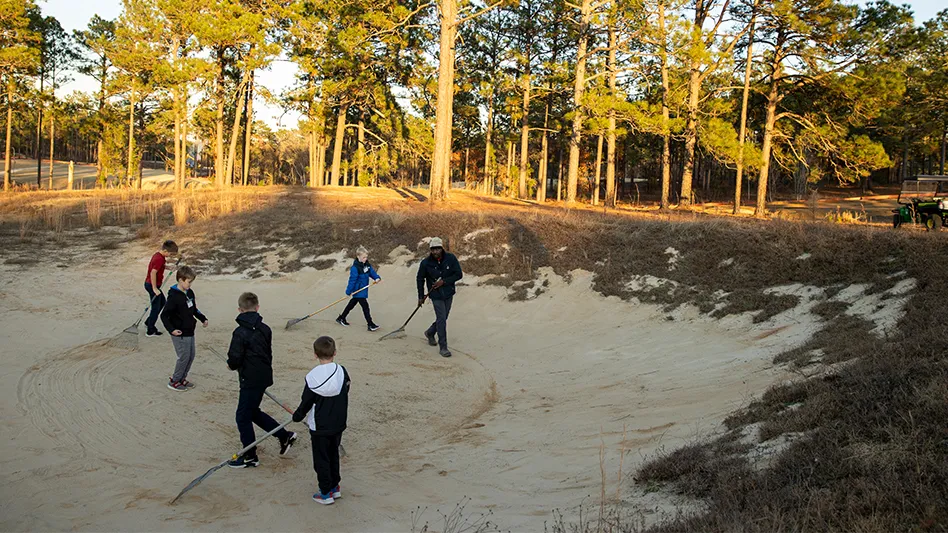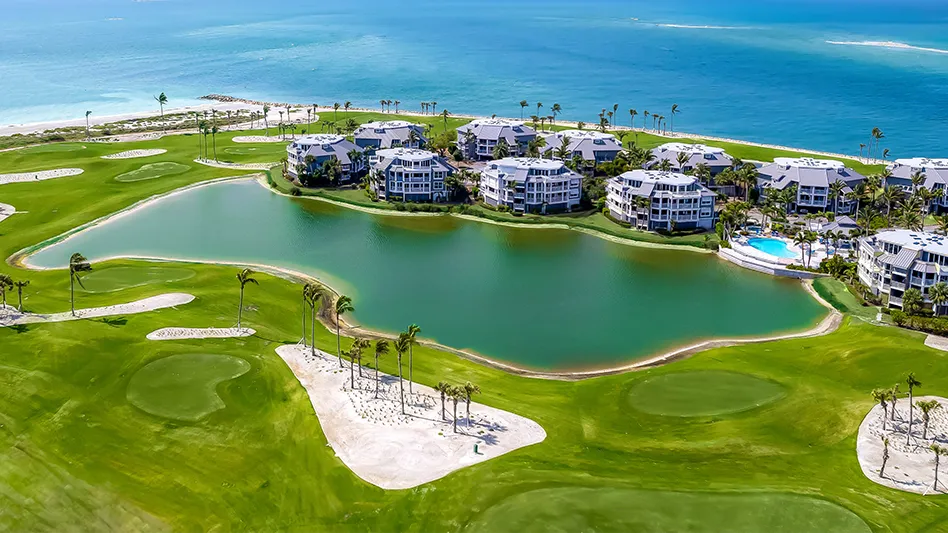This year, golfers may see more wildflowers replacing the trim turfgrass traditionally seen in out-of-play areas on golf courses across the country. While there may be more complaints coming from members’ missing golf balls, the efforts of superintendents across the country are saving maintenance time and helping local ecosystems.
Golf courses have been widely criticized for the perception that they lack of conservation efforts and negatively affect the surrounding environment. Converting highly maintained areas to native spaces, which are typically out-of-play areas designed to allow indigenous grasses and wildflowers to flourish without excessive upkeep, provides superintendents a way to reduce the amount of fossil fuels, fertilizers and water used on golf courses without significantly increasing maintenance costs. Many of the native plants used require less water and manicured mowing maintenance than the traditional types of turfgrass used on greens, tees and fairways.
While native spaces allow superintendents to reduce inputs, possibly save on labor and enhance the course’s wildlife population, there are some challenges to consider before planting wildflowers or letting once manicured areas grow wild.
The pros
Pop star Justin Timberlake opened Mirimichi outside of Memphis, Tenn., earlier this summer to a lot of buzz about being a "green" facility. The course has more than 7,400 yards of playable turf, but during the renovation the grounds staff cut the mowable acres on the course down from 210 to 95, says director of agronomy Kenny Herzog. Mirimichi, formerly Big Creek Golf Course, is the first Audubon International Certified Classic Sanctuary and is on track to have the first LEED Platinum-Certified clubhouse when it’s completed in 2011. This reduction in mowable acres not only cuts down on the amount of labor used to maintain the course, but also the amount of fossil fuels used in the process.
"Through trial and error, we’ve learned a lot," Herzog says. Mirimichi’s reduction in mowable acres should help keep its equipment in better condition longer, as it reduces the wear and tear on mowers.
"It takes a few years to get the native grasses established," Herzog says, adding the first year after the grass germinates, the area is sparse, but weed control is usually light. Throughout the second year, the spaces usually maintain themselves better and by the third year, the grass is decisively established.
"The native grasses we established the first year are really looking beautiful," he says.
Native spaces can dramatically cut down on the amount of pesticides and fertilizers used in the treatment process. David Phipps, superintendent of Stone Creek Golf Club in Oregon City, Ore., utilizes both a fescue mix as well as native prairie species on a nature trail surrounding the green to enhance the local supply of these disappearing plants.
"This adds a really neat dimension to the course," says Phipps, who is the 2009 GCSAA/Golf Digest Environmental Leader in Golf Award winner. Stone Creek’s features were pocket-planted along the fairways as well as surrounding a nature trail that stretches into the property. The course was designed to utilize natural elements and native plant species when it was built in 2002. Phipps’ maintenance crew does not regularly fertilize the native spaces and those areas also are free of irrigation.
Native grasses have helped golf courses attract more local wildlife, as well. At the Hillcrest Golf and Country Club, located in Batesville Ind., members have commented to superintendent Chad Miller that the amount of wildlife seen on the course has increased since the maintenance staff began cultivating native pockets surrounding the golf course.
Stone Creek also had an increase in wildlife after establishing native areas, especially in the number of raptor sightings as well as other bird species.
The challenges
While many of the benefits are apparent to superintendents, some members and players, may not enjoy these new features at first. Hillcrest had about 50 complaints at the beginning of the season when the club chose to start cultivating native pockets surrounding the course.
"We took a beating early on, but then we showed them a great product," Miller says. Since club members were used to wall-to-wall manicured turfgrass in the past, members complained about the "ragged" appearance of the newly created native spaces at first. Miller listened to players and has worked to add color to the course through patches of wildflowers. He also has scaled back the native areas, based on member feedback, to reduce the amount of lost balls. While Miller believes it’s important to have the course look clean and welcoming for members, he feels this initiative is the right thing to help the course improve its sustainable practices.
Phipps also had to deal with disgruntled Stone Creek golfers during the program’s first year. Golfers frequently complained about losing golf balls in the native areas. Stone Creek, however, was constructed to include many sustainable measures, so the problems with disgruntled members were overcome by pointing out the facility’s mission statement.
Although native spaces do relieve the costs of mowing, irrigation and chemical inputs, broadleaf and other invasive weeds do crop up before and during the season.
Herzog and his crew have committed a lot of time during the 2009 season working on eliminating their weeds through a labor-intensive alternative rather than chemical or mechanical processes.
"Right before opening, we took our crew out and earnestly worked on specific spaces," Herzog says. The weeds were hand-pulled to create the most aesthetically pleasing space as possible. While this may seem extreme to some, the team at Mirimichi puts in the time in during 2009 in anticipation for a better product in the coming years, Herzog says.
"We hope to have our native grasses established and hope to have our crew size down," Mirimichi superintendent, Dustin Green, says of this year’s goals. Right now, Herzog and Green have been working with a staff of 44 on the grounds crew and a budget of approximately $1.5 million.
While many superintendents create native areas as a way to create sustainable practices, many superintendents realize the cost effective potential of these programs as well. By cutting back on the heavily manicured areas, Miller was able to utilize his labor on other projects around the Batesville facility.
"It doesn’t necessarily cut costs, but lets us produce a better product by reallocating our resources," Hillcrest’s Miller says. With the extra labor, he plans to restore a stream that runs through the property with the help of a pond and stream restoration expert this year.
Phipps agrees, adding while the immediate cost savings are not that significant, the program does cut down on other indirect costs. In the end, facilities with this type of program may see overarching cost savings, but currently the program is most successful in allowing superintendents to reassign their labor for other projects.
GCIMegan Leonhardt is a freelance writer based in Medina, Ohio.

Explore the January 2010 Issue
Check out more from this issue and find you next story to read.





